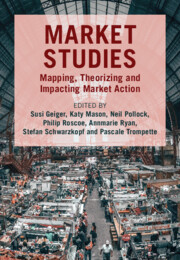Book contents
- Market Studies
- Market Studies
- Copyright page
- Contents
- Figures
- Tables
- Contributors
- Acknowledgements
- Introduction: The Multiple Pasts, Presents and Futures of Markets and Market Studies
- Part I Market Designs and Market Misfires
- Part II Post-Performative Approaches to Studying Markets
- Part III Valuation
- Part IV Markets in Motion: Places and Spaces
- Part V The Secret Life of Market Studies Methods
- Part VI Broadening the Perspectives in Market Studies
- Part VII Future (Im)Perfect Markets
- Index
- References
Part I - Market Designs and Market Misfires
Published online by Cambridge University Press: 22 November 2024
- Market Studies
- Market Studies
- Copyright page
- Contents
- Figures
- Tables
- Contributors
- Acknowledgements
- Introduction: The Multiple Pasts, Presents and Futures of Markets and Market Studies
- Part I Market Designs and Market Misfires
- Part II Post-Performative Approaches to Studying Markets
- Part III Valuation
- Part IV Markets in Motion: Places and Spaces
- Part V The Secret Life of Market Studies Methods
- Part VI Broadening the Perspectives in Market Studies
- Part VII Future (Im)Perfect Markets
- Index
- References
Summary
At its simplest, the Market Studies discipline is based on the idea that markets are organized – which is one of the reasons why Market Studies scholarship often overlaps with organization studies (Ahrne, Aspers and Brunsson 2015; Geiger and Gross 2018; Palo, Mason and Roscoe 2019). Though often decentrally and organically evolving, this organization typically is at least partly the result of deliberate shaping, engineering or design efforts by some market actors. Much attention in Market Studies has been given to acts of market making, which we define here as the multi-actor efforts of creating a market organization through socio-material assemblages according to certain organizational principles and directed towards certain goals. These efforts typically result in what Koray Çalışkan and Michel Callon (2010) encapsulate through their famous notion of ‘market socio-technical agencements’, or market STAs (or, even shorter, mSTAs).
- Type
- Chapter
- Information
- Market StudiesMapping, Theorizing and Impacting Market Action, pp. 19 - 96Publisher: Cambridge University PressPrint publication year: 2024

